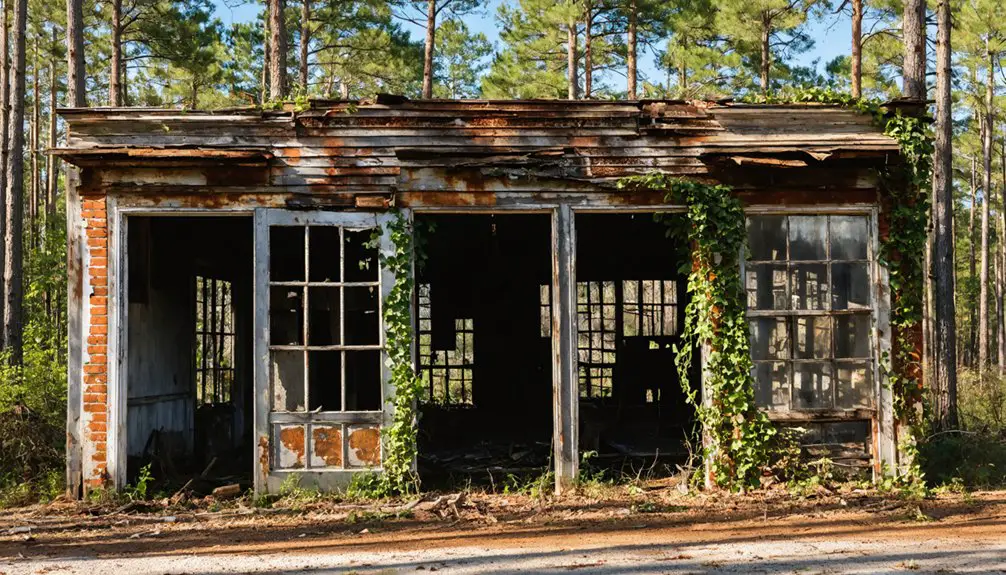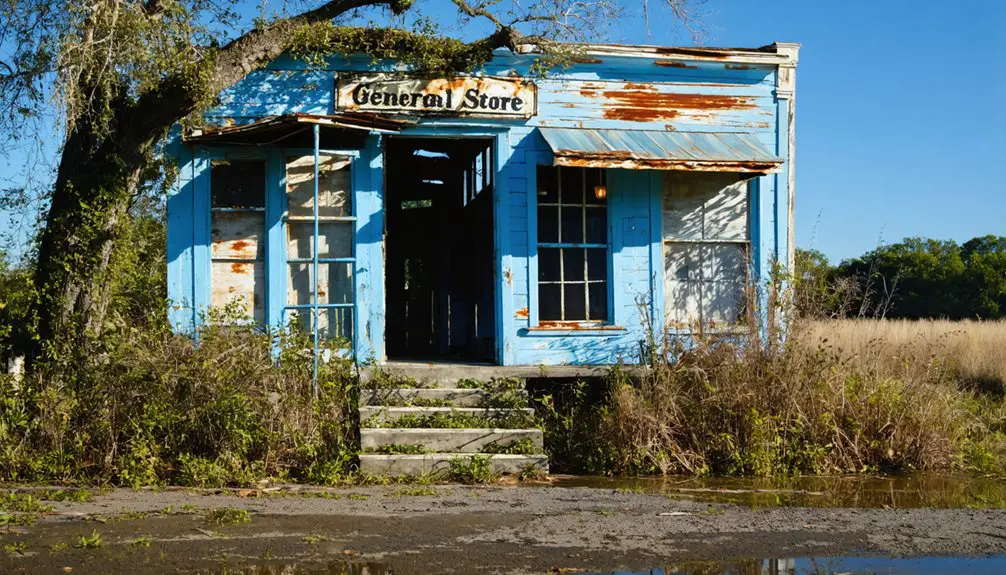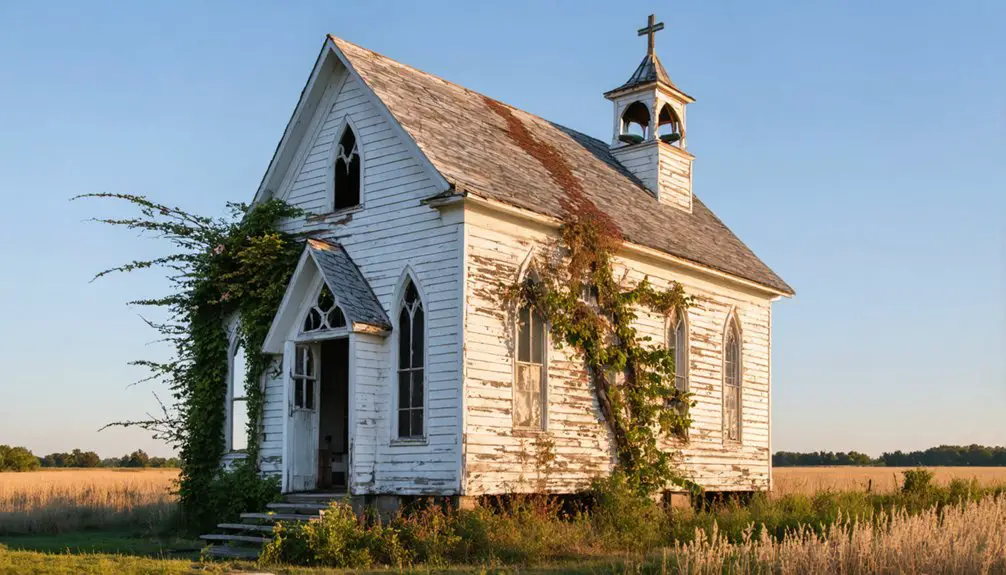You’ll find Yale, Mississippi five miles north of Tremont and one mile west of State Highway 23N. This ghost town‘s most significant feature was the Oakland Normal Institute (1887-1904), which transformed a tiny rural settlement into an educational beacon. Though the town never exceeded 21 residents, its institute prepared rural youth for higher education and earned Mississippi Historical Landmark status in 2004. The story of Yale’s rise and fall reveals surprising connections to America’s educational heritage.
Key Takeaways
- Yale was a small Mississippi settlement that never exceeded 21 residents and became abandoned following economic decline and institutional closures.
- The town’s post office operated from 1891 to 1907, serving as a vital communication hub before its closure marked declining prosperity.
- Oakland Normal Institute (1887-1904) was Yale’s educational cornerstone, later becoming a county school until its complete closure in 1954.
- The settlement is located five miles north of Tremont and one mile west of State Highway 23N in Mississippi.
- Few original structures remain today, with most historical evidence limited to ruins, foundations, and old burial sites.
The Rise of a Small Educational Hub
While Yale University’s influence reached across America, its unexpected impact on Mississippi’s educational landscape emerged through a cadre of Yale Law graduates who taught at the University of Mississippi from 1946 to 1970.
You’ll find their presence sparked a transformation in the state’s educational approach, bringing progressive thought to a region steeped in tradition.
The University of Mississippi had already established itself as the state’s premier institution since 1848, hosting both law and medical programs. After opening, the university quickly created the fourth state-supported law school in the United States in 1854.
When Yale-educated professors arrived, they introduced educational diversity that challenged local norms, particularly regarding race relations and states’ rights. Founded in 1701 in Connecticut, Yale’s own complex history with slavery and social change would parallel many of the challenges these professors faced in Mississippi.
Despite facing resistance, these educators helped create intellectual spaces where new ideas could flourish. Their influence extended beyond the classroom, contributing to broader social changes that would reshape Mississippi’s academic future.
Oakland Normal Institute’s Legacy
The establishment of Oakland Normal Institute in 1887 marked a pivotal moment in Yale, Mississippi’s educational history. You’ll find its educational evolution reflected in the classical curriculum, which included Latin and art, alongside practical courses in business and education to prepare rural youth for college life. The Institute proudly served as a bridge to higher education for the rural community.
The institute’s legacy lives on through notable alumni achievements, including U.S. Representative T. Jeff Busby and former U.S. Attorney General John Breckinridge. The one-story building was constructed in the 1930s using materials salvaged from the original two-story structure.
After shifting from a private academy to a county school in 1904, it continued shaping young minds until 1954.
Today, you can visit the preserved site, which earned Mississippi Historical Landmark status in 2004. The grounds still feature historical elements like the original water pump and 1950s drinking fountains, evidence of the institution’s role in bringing “the torch of light” to the Mississippi Hills region.
Life in Early Yale Settlement
During the late eighteenth century, Yale’s settlement patterns mirrored those of neighboring communities in Mississippi and Arkansas, where families like Fogle and Buleet established themselves as early as 1769.
The early community dynamics revolved around extended family networks, with settlers establishing homesteads along essential waterways and transport routes. You’d find these pioneers engaging primarily in agricultural practices, cultivating cotton, tobacco, and subsistence crops on the fertile Mississippi valley soil. Much like the later Yale Camp operations, these early settlements focused on utilizing natural resources and building strong community ties. The settlement had remarkable parallels to Connecticut’s high literacy rate, with community education being a priority among families.
Life centered around family bonds and communal cooperation, with settlers working together during planting and harvest seasons. The community’s social fabric wove together through shared religious gatherings and informal labor exchanges.
Frontier settlers forged tight-knit communities through shared labor, worship, and kinship bonds, creating a resilient social network amid harsh conditions.
While infrastructure remained basic, consisting mainly of farmsteads and household buildings, these close-knit settler groups maintained strong cultural ties through kinship and shared frontier experiences.
The Decline and Abandonment
You’ll find the seeds of Yale’s decline in two critical developments: shifting transportation patterns that bypassed the once-strategic settlement and the closure of Oakland Normal Institute in 1904.
The institute’s transformation from an independent classical academy into a county school marked a significant downgrade in Yale’s educational prominence. This decline stood in stark contrast to the educational legacy of Yale College’s founding in 1701. Much like in Rodney, Mississippi, which saw its population plummet from 4,000 residents in 1860, Yale experienced a dramatic exodus of its community.
When you consider how these changes coincided with the post office’s closure in 1907, it becomes clear that Yale was losing both its commercial relevance and institutional foundations.
Transportation Routes Changed
While major transportation developments in Mississippi reshaped the region’s economic landscape, Yale found itself increasingly isolated from essential trade routes that once sustained its small community. Drawing parallels to how Yale’s original location changed multiple times before settling in New Haven, this Mississippi town also faced geographic challenges. Unlike towns that thrived along river routes, where showboats brought vital entertainment and commerce to communities, Yale struggled without waterway access. The town was bypassed by State Highway 23N, which favored nearby Tremont, just five miles south. The economic implications were severe – without access to major rail lines or river routes, Yale’s businesses suffered from reduced commerce and trade.
Academy Closure Impact
As the Oakland Normal Institute shuttered its private academy operations in 1904, Yale’s identity as an educational center began to crumble.
You’d have witnessed the stark educational disparity emerge as specialized classical education and business courses vanished, leaving only basic county schooling in their wake. The academy’s closure struck at the heart of Yale’s community identity, eliminating cultural events and dampening local aspirations.
You can trace the town’s rapid decline through the numbers – from a population of 21 in 1900 to the post office’s closure in 1907.
The loss of educated residents, coupled with diminished opportunities for youth, accelerated Yale’s transformation into a ghost town. Without its prestigious academy drawing new settlers and sustaining economic activity, Yale’s remaining infrastructure deteriorated until the community completely disbanded.
Historical Remnants and Landmarks

Located five miles north of Tremont and one mile west of State Highway 23N in Itawamba County, Yale stands today as a silent memorial to Mississippi’s vanished settlements.
Nestled in rural Itawamba County, Yale remains a ghostly testament to Mississippi’s forgotten frontier communities.
You’ll find few intact structures from its operational period, with most historical artifacts reduced to scattered ruins and foundations amid overgrown vegetation.
The town’s most significant landmark was the Oakland Normal Institute, which operated from 1887 to 1904.
While the academy’s physical remains are limited, its legacy as a center for classical education endures.
You can still trace the old pathways connecting Yale to surrounding areas, and burial sites from the period, though often obscured by nature’s reclamation, offer valuable insights for genealogical research.
The former post office location also marks an important communication hub from 1891 to 1907.
Yale’s Impact on Regional Development
Despite its modest size, Yale played a significant role in shaping regional development through the Oakland Normal Institute, which served as a cultural and educational beacon from 1887 to 1904. You’ll find that the institute’s classical curriculum, including art, Latin, and business courses, helped establish educational standards that influenced teacher training throughout the region.
While Yale’s population never exceeded 21 residents, its strategic location near State Highway 23N and Tremont fostered community cohesion through its post office and educational facilities.
The institute’s shift from private to public education in 1904 demonstrates Yale’s commitment to accessible learning. Though the town eventually succumbed to rural decline, its legacy lives on through the alumni who carried their knowledge into surrounding communities, contributing to Mississippi’s broader cultural and educational development.
Frequently Asked Questions
What Natural Disasters or Epidemics Affected Yale During Its Inhabited Period?
You won’t find documented flooding events or major disease outbreaks during the town’s inhabited period, though the area experienced typical Southern weather patterns and regional health challenges common to Mississippi.
Were There Any Notable Graduates From the Oakland Normal Institute?
You’ll find two famous alumni who shaped America: T. Jeff Busby served as U.S. Representative from Mississippi, and John Breckinridge became U.S. Attorney General, establishing the institute’s lasting educational legacy.
What Native American Tribes Originally Inhabited the Yale Area?
Like ancient roots intertwined in Mississippi soil, you’d find the Choctaw tribe dominated the Yale area, with populations reaching 15,000. The Chickasaw Nation also maintained a presence in surrounding regions.
Did Yale Have Any Significant Role During the Civil War?
You won’t find significant evidence of Yale’s Civil War impact, as historical records don’t mention this small Mississippi settlement playing any notable role during the conflict between Union and Confederate forces.
What Businesses and Industries Operated in Yale Besides the School?
You’ll find evidence of local agricultural practices, a post office that operated until 1907, small retail shops, and likely some timber industry activity, though records remain limited for most businesses.
References
- https://mississippifolklife.org/articles/haunted-by-a-ghost-town-the-lure-of-rodney-mississippi
- https://en.wikipedia.org/wiki/Yale
- https://kids.kiddle.co/List_of_ghost_towns_in_Mississippi
- https://www.youtube.com/watch?v=pinIgUFWDT0
- https://www.youtube.com/watch?v=0PNKwJNRd_E
- https://aquila.usm.edu/cgi/viewcontent.cgi?article=1087&context=dissertations
- https://en.wikipedia.org/wiki/History_of_the_University_of_Mississippi
- https://yaleandslavery.yale.edu
- https://law.olemiss.edu/about/history/
- https://environment.yale.edu/forest-school/about/history



